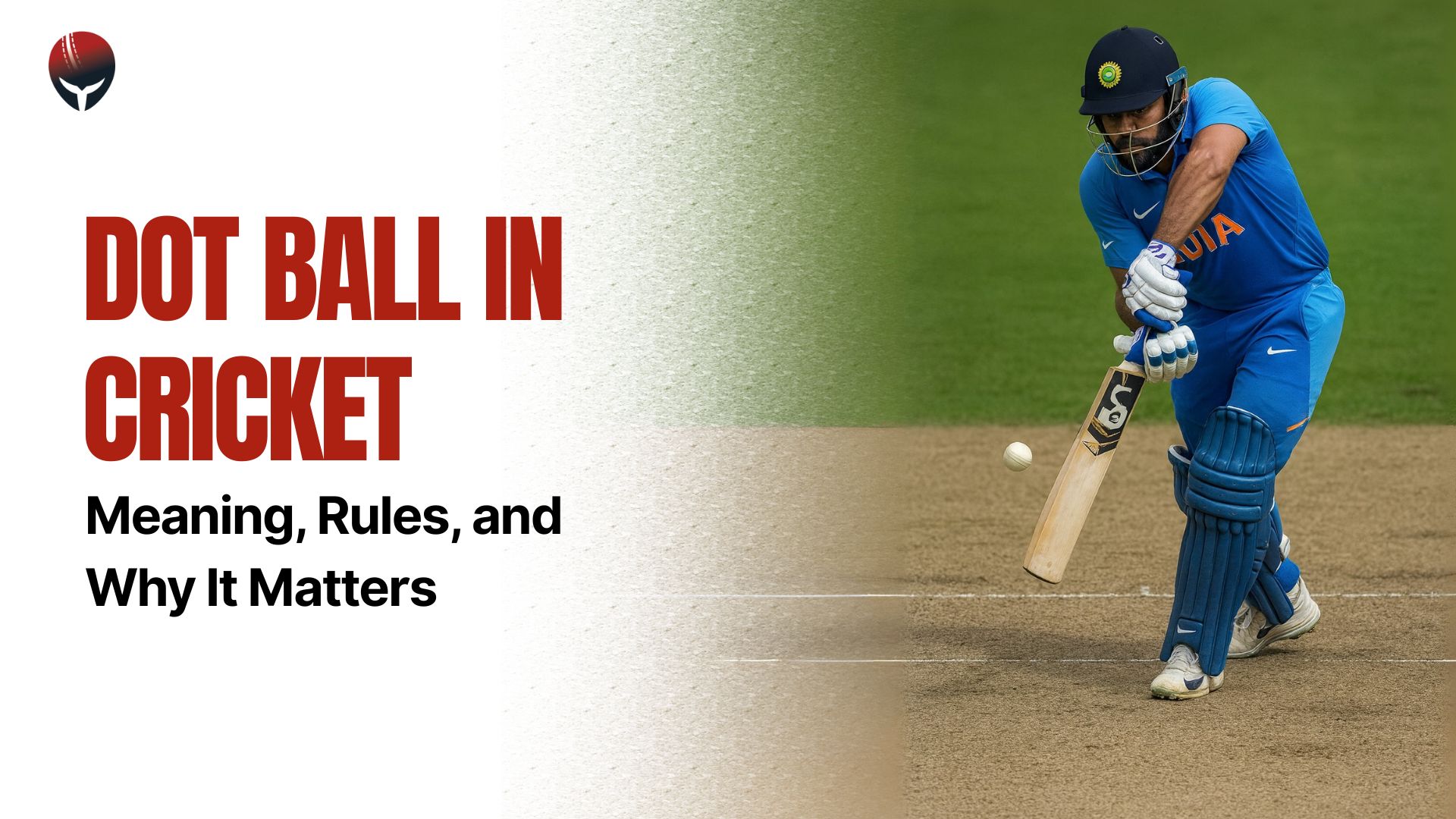A dot ball in cricket might seem like just another delivery, but it can change the entire game. Bowlers rely on it to build pressure, captains use it to plan field placements, and batsmen dread it when trying to rotate the strike. In short formats like T20s, every dot ball can swing momentum.
This post breaks down the meaning of a dot ball in cricket, how it works, its effect on matches, and even answers some unique questions like how many trees might match one dot ball. Whether you’re a casual fan or a cricket nerd, this guide is made for you.
What Is a Dot Ball in Cricket?
A dot ball in cricket is a legal delivery where no runs are scored by the batter, and no extras are given. It’s called a “dot” because scorers often mark it as a dot in the scorebook.
You’ll see it happen when:
- The batter plays a defensive shot.
- The ball misses the bat completely.
- A wicket falls without runs.
- The batter is unable to run after making contact.
Despite the name, a dot ball is not always a defensive move. Some dot balls are full of drama—especially when they’re part of a tight finish.
Rules That Define a Dot Ball
Here’s how cricket defines a dot ball:
- Legal delivery: It must not be a no-ball or wide.
- No runs: The batting side doesn’t score from that ball, including extras.
- Wickets count: If a batter gets out and no runs are made, it’s still a dot.
- Extras matter: If an extra run like a wide or bye is awarded, it’s not a dot.
Cricket Q&A
Five quick questions. Get a personal tip.
These rules apply across all formats—Tests, ODIs, and T20s.
Why Dot Balls Matter in Cricket Matches
Dot balls might seem small, but their impact is massive. Here’s why they matter:
- Builds pressure: Multiple dot balls in a row can frustrate batters.
- Forces mistakes: A string of dot balls can push a batter into taking risky shots.
- Affects run rate: In limited-overs formats, dot balls slow down the scoring rate.
- Bowler confidence: Dot balls give bowlers the upper hand and keep them in rhythm.
In T20 cricket, even a single dot ball in the final over can shift the outcome. Teams often measure performance by dot-ball percentages.
Dot Balls in Different Formats
Let’s break down how dot balls behave in each format:
Test Cricket
- Batters don’t mind facing dot balls as they build their innings.
- Dot ball pressure is less intense due to unlimited overs.
- Bowlers still use them to tire out batters.
ODI Cricket
- Dot balls slow momentum between boundaries.
- Good bowling spells often include many dot balls.
- Fielding sides look to squeeze dot balls during middle overs.
T20 Cricket
- Every dot ball feels like gold.
- Teams celebrate maiden overs like wickets.
- Bowlers aim to deliver more dot balls in the death overs.
Most Dot Balls Played by a Batsman in International Cricket
Dot balls aren’t just about bowling. Some of the greatest batters in the world have faced thousands of them. This usually happens in Test cricket, where batters spend long hours building an innings with patience.
Here are a few players who have played the most dot balls in international cricket (as of 2024):
- Rahul Dravid (India) – Over 16,000 dot balls
- Sachin Tendulkar (India) – Around 15,300 dot balls
- Jacques Kallis (South Africa) – Close to 15,000 dot balls
- Shivnarine Chanderpaul (West Indies) – Over 14,000 dot balls
- Ricky Ponting (Australia) – Nearly 13,800 dot balls
These batters were known for their ability to stay at the crease, block out bowlers, and build an innings. It’s not a weakness—it’s part of their strength.
Who Played the Most Dot Balls in Cricket History?
The player who has played the most dot balls in cricket history is Rahul Dravid.
Nicknamed “The Wall,” Dravid was known for his technique and patience. He often played long innings, especially in Test matches. Facing over 16,000 dot balls in his international career, Dravid didn’t just survive—he laid the foundation for big team scores.
This shows that dot balls don’t always mean failure. In longer formats, they can be a smart strategy
Famous Matches Where Dot Balls Changed Everything
Here are a few memorable games where dot balls made the difference:
- T20 World Cup 2022 Semi-Final
In a tight chase, England bowled several dot balls to break India’s rhythm. The pressure created by dot balls made key batters play risky shots and lose their wickets. - IPL 2021 Final: CSK vs KKR
Deepak Chahar bowled a brilliant spell with back-to-back dot balls, stopping KKR’s scoring in the powerplay. That early choke helped Chennai win comfortably. - World Cup 2019: India vs Afghanistan
Mohammad Shami bowled a final over full of dot balls before sealing the game with a hat-trick. Those dot balls forced Afghanistan into panic.
These games show that even when there are no wickets, dot balls can shift momentum.
How Many Trees for One Dot Ball?
This isn’t a science rule—it’s just a fun way to connect cricket with the environment.
In big cricket matches like the IPL, World Cup, or domestic leagues, a lot of paper gets used. Teams print out scorecards, match sheets, team plans, and ball-by-ball data. Even with digital tools, printed documents are still common—especially for scorers, coaches, broadcasters, and analysts.
Here’s a simple way to look at it:
- One tree makes around 8,000 sheets of paper.
- Let’s say one dot ball saves one sheet of paper (just for fun—not literal).
- That means 8,000 dot balls = 1 tree saved.
Let’s take the IPL as an example:
- Each IPL season has around 74 matches.
- Each match includes about 250–300 dot balls.
- That adds up to over 20,000 dot balls per season.
So, if we stick with this idea, the dot balls in one IPL season could save around 2 to 3 trees.
Now imagine this across all international cricket, domestic games, and leagues—easily over 200,000 dot balls a year. That’s like saving 25 trees or more using this fun comparison.
We’re not saying dot balls literally save trees. But the point is simple: small things matter. Just like one dot ball can change a match, one sheet of paper saved can make a difference over time.
Cricket rewards smart choices—and so does nature.
Tips to Bowl More Dot Balls
Bowlers use dot balls to get control. Here’s how they do it:
- Stick to a good line and length
Target the top of off-stump or just outside. - Use variations
Change pace, angle, or bounce to confuse the batter. - Set a smart field
Place fielders where the batter’s strong shots usually go. - Focus on consistency
One dot ball won’t help, but three or four in a row will build real pressure. - Read the batter’s body language
Anticipate where they want to hit and bowl accordingly.
Dot balls are not only about skill. They’re also about game awareness and patience.
Final Thoughts
Dot balls in cricket don’t get the same attention as wickets or boundaries, but they quietly control the match. Whether you’re a bowler aiming to keep things tight, a batter trying to rotate the strike, or a fan watching the tension rise—dot balls are everywhere.
They may not score points, but they win games.
What’s your favorite dot ball moment in cricket?
Share it in the comments below. And if you found this helpful, pass it along to a fellow cricket fan.
FAQs
What is a dot ball in cricket?
A dot ball is a delivery where the batting team scores no runs and no extras are awarded.
Why is it called a dot ball?
Scorers mark such deliveries with a dot in the scorebook, hence the name.
Does a wicket count as a dot ball?
Yes, if no run is scored, a wicket delivery is considered a dot ball.
Are dot balls good in cricket?
Yes, especially for the fielding team. They build pressure and can lead to mistakes.
Can a wide be a dot ball?
No. A wide gives the batting team an extra run, so it’s not a dot ball.
Do dot balls matter in T20 cricket?
Very much. In short formats, every dot delivery can impact the outcome.
Who has played the most dot balls in history?
Rahul Dravid has faced the most dot balls in international cricket.
Who has bowled the most dot balls in T20 cricket?
Bhuvneshwar Kumar and Sunil Narine are among the top dot-ball bowlers in T20s.
Is a no-ball considered a dot ball?
No. A no-ball is an illegal delivery and adds an extra run, so it’s not a dot.
How many dot balls are in a maiden over?
Six. A maiden over has no runs and no extras from all six balls.

I am Manan Joshi , SEO All-Rounder at CricHeroes.
CricHeroes is the ultimate Cricket Scoring App and the world’s only true Cricket Network. With more than 4 crore+ registered cricketers using CricHeroes to Live Cricket Scores for their local cricket matches and tournaments, CricHeroes is already the #1 Cricket Scoring App Globally!
We also proudly present “CricHeroes Store” by CricHeroes, a dedicated shop for cricket apparel and accessories, helping players gear up for their game.















